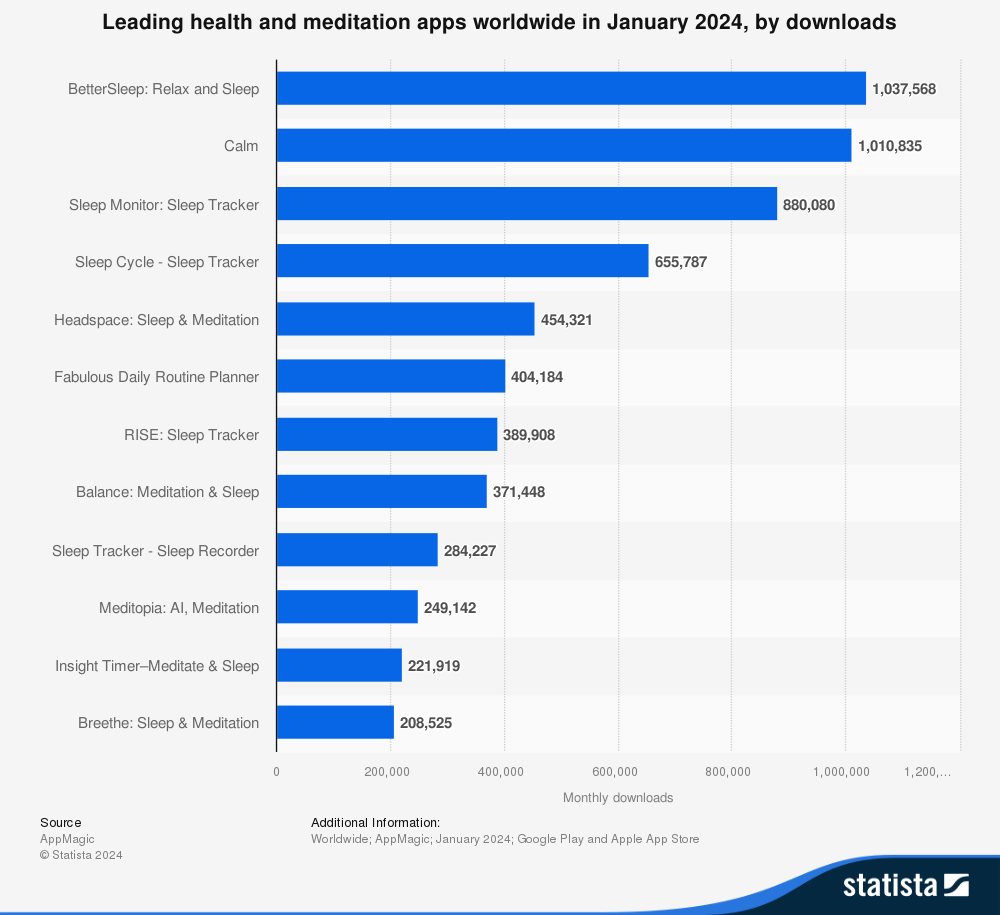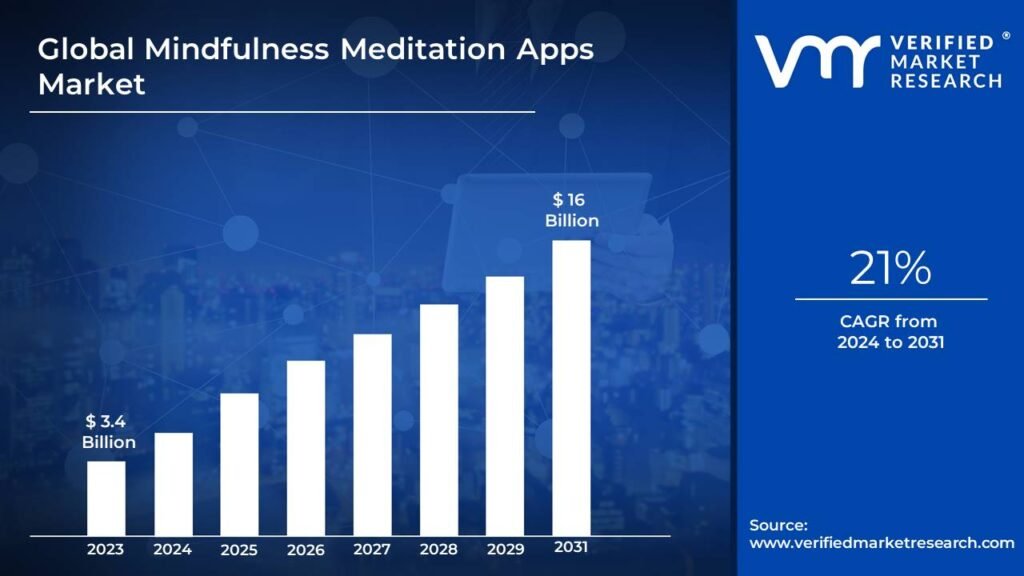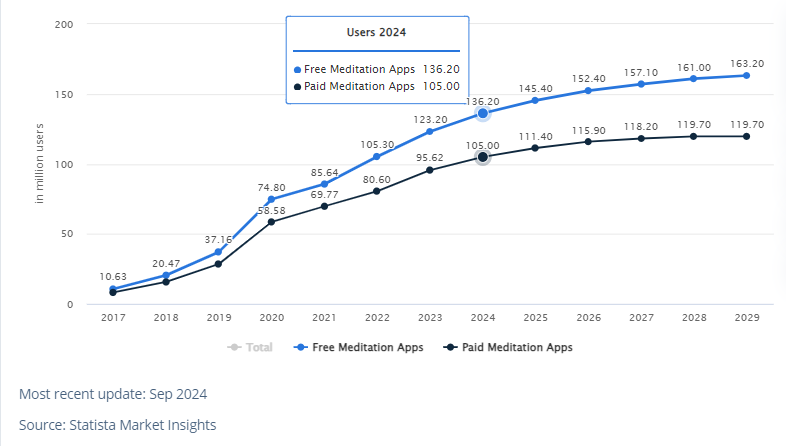
As the world speeds up, an increasingly large group of people seeks a moment of Zen from their smartphones. But how many people are embracing digital mindfulness? Now that 2024 is here, meditation apps have become a cornerstone in many routines. From stressed executives to curious millennials, these apps are shifting how we deal with our mental health and relaxation. This article explores the exciting world of meditation app usage, considering modern trends, user demographics, and the effects of digital wellness tools.

The Expanding Universe of Meditation App Users
By 2024, the number of users of meditation applications was unmatched.
Millions worldwide engage with these digital intervention tools regularly, showing remarkable growth compared to previous years. This rise in users can be linked to:
- Increased awareness about mental health benefits
- The accessibility of mobile meditation
- Lagging effects of global stressors
the COVID-19 pandemic accelerated the trend as many people turned toward meditation apps to cope during lockdowns. Now, with mindfulness practices becoming more mainstream, these apps have been woven into the digital wellness space, helping users achieve inner peace and clarity.

Who’s Meditating?
There is a considerable variety in the demography of the users of meditation applications with respect to different age groups and geographical locations. Below are the major points regarding the user base:
Generational Trends
- The major user groups are the Millennials and Generation Z as they have played key roles in the providing these digital wellness solutions.
Gender Balance
- There are slightly more women than men; this gender ratio is also seen in the larger wellness space.
Urban vs Rural Use
- Meditation app usage is higher among urban users; this may be attributed to stress factors and technology.
Older Adults Joining the Trend
- Participatory in nature aged above 55 years users are keen on the use of meditation apps trends indicating acceptance of the trends across the ages.
This differential user base indicates that today, as opposed to earlier periods, a radiation app is accepted across ages and regions.
Consumer Spending Patterns
In 2024, the average spend of a global user of mobile meditation and mental wellness apps was 51.31 U.S. dollars per user. This is a reflection of the increased interest in digital wellness, as the number of people using mobile applications for mental health maintenance increases.

Projected Spending Growth:
It also projected individual spending to reach 60 U.S. dollars by 2027, driven by:
- Premium features
- Custom meditation plans
- Subscription models
- AI-powered mental health too
This rise in consumer expenditure shows the increasing demand for available and quality digital wellness products.
Daily usage patterns
They fit into the users’ daily routines, from the various sessions at any time of the day.
- Morning Meditations
- Mindfulness keeps many users in tune with starting their day on a very positive note.
- Midday Sessions
- The flexibility in work arrangements lets users take their mental health breaks over lunch.
- Evening Wind-Down
- It relaxes users in the evening before sleeping.
These patterns illustrate how meditation apps have become integrated into the users’ daily lives, enabling flexibility and accessibility. Market-leading Meditation Apps and their Revenues Because meditation app market competition is so high, a few top players dominate.
Market Leading Meditation Apps and Their Revenues

The meditation app industry is highly competitive, with several players dominating the market. Here are some top-performing apps and their strategies:
- Calm:
- Known for airline partnerships and corporate wellness programs.
- Headspace:
- Focuses on scientific research and healthcare collaborations.
- Insight Timer:
- Success driven by its freemium model, offering both free and premium content.
- Buddhify:
- Popular for its “meditation on-the-go” approach.
- Ten Percent Happier:
- Co-founded by ABC news anchor Dan Harris, promoting mindfulness in a practical way.
The combined revenues of these top apps underscore the economic impact and growth potential of the digital mindfulness industry.
Evolution of Meditation Apps

- More Common Than Ever:
- Meditation apps could soon be as prevalent as social media or weather apps.
- Wearable Technology:
- Smartwatches are likely to offer built-in meditation tools for quick sessions.
- Corporate Wellness Programs:
- Companies increasingly provide meditation apps to employees to reduce stress and boost productivity.
- Pre-Installed Wellness Apps:
- Future smartphones might come with meditation apps installed by default, similar to music or game apps.
Meditation apps are redefining how we think about mental well-being, just as gyms changed how we approach physical fitness.
Conclusion
Meditation applications have grown to become a part of the landscape of wellness for all kinds of users in almost every aspect, developing hand in glove with their customers’ needs. The more people are aware of mental health, the more these digital tools will be accepted. Meditation applications, due to their premium features, personalized plans, and innovative technologies, have been considered a very important tool for achieving sharp mental clarity and emotional balance-now and far into the future.

